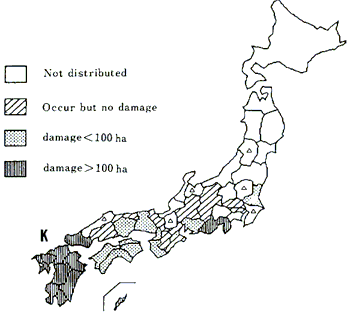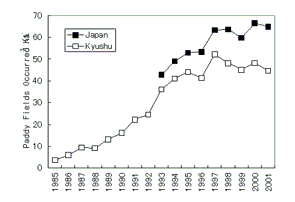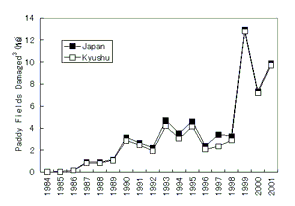| Current status of the apple snail Pomacea canaliculata in Japan |
Yoichi Yusa* and Takashi Wada**
National Agriculture Research Center for Kyushu Okinawa Region,
Nishigoshi, Kumamoto 861-1192, Japan.
* E-mail: yusa@affrc.go.jp
**E-mail: twada@affrc.go.jp
Brief history
The apple snail Pomacea canaliculata (Ampullariidae) was introduced into Japan for human food, mainly in the early 1980’s (Wada, 1997; Yusa and Wada, 1999). At first the commercial culture of apple snails was common, and as many as 495 farms were open in 1983. But soon the culture industry declined due to the lack of a good market, and escaped or abandoned snails became wild. In 1984, damage to rice was first reported, and in the same year, the snail was designated as a quarantine pest by the Japanese Government.
Current distribution
Fig. 1 shows the province (prefecture)-based distribution of the apple snail in Japan in 1995 (Wada, 1997); the distribution has not changed so much since then. The snails are distributed in southern Japan, and northern distribution is limited by the low temperature in winter. In some provinces, snails were reported to be once distributed but disappeared.
Figure 1.  Province-based distribution of the apple snail, Pomacea canaliculata, in Japanese paddy fields, according to the report (1995) by Plant Protection Department, MAFF, Japan. : |
The provinces with heavy damages (>100 ha) were mostly in Kyushu Island.
This is partly because of the warmer winter in Kyushu, making snail survival
higher. Another reason is that the transplanting season in Kyushu is June, when
the rainy season starts. Thus, paddy fields are often flooded unexpectedly and
water control is impossible just after the transplanting or direct seeding,
when the rice plants are small and susceptible to snail attack.
The acreage of apple snail distribution had increased year by year, but seems
to have reached a plateau from 1997 (Fig. 2). In 2001, the snail occurred in
around 65,000 ha in Japan, and about 70 % of the area (45,000 ha) was in Kyushu
Island. This area comprised about 20 % of the total rice-growing area (203,000
ha) in Kyushu.
Figure 2.  Annual occurrences of the apple snail, Pomacea canaliculata, in Japanese rice fields. |
Figure 3.  Annual paddy acreage damages by the apple snail, Pomacea canaliculata, in Japan. |
Control methods
The most important method for snail control in transplanting rice is to keep
paddy water low (Ozawa and Makino, 1997). It is also the most widely applied
practice. The application of chemicals depends on the conditions of the fields
as well as farmer’s attitude to this snail. In areas where water control
is difficult, as in the flat plains near the sea, application of molluscicides
or repellents (such as IBP) are common. Some farmers even use unregistered molluscicides
(metaldehyde or camellia seed cake; the former is being under registration).
On the other hand, if the water control of the fields is relatively easy, chemical
control is less common and many farmers do not regard the snail as a major pest.
In the snail-susceptible areas, hand picking of snails and egg masses is also
common, but its effectiveness to reduce the density in the next generation is
somewhat doubtful unless completely done (Tanaka et al., 1999). Intensive tillage
reduces the density of the snails, especially of large snails (Takahashi and
Seki, 2001; Kiyota and Sogawa, 1996).
In Japan, farmers conduct direct seeding in less than 1 % of the total rice-growing
fields. However, the Ministry of Agriculture, Forestry and Fisheries promotes
direct seeding to reduce the costs for rice production. As younger rice is more
susceptible to snail feeding, damage is much severer under wet direct seeding
than transplanting. Dry seeding is better to avoid snail attack, but in practice
it is not widespread due to the weed and water-leakage problems.
Under wet seeding, draining water is the most important method to avoid damage.
Longer draining up to 2 or 3 weeks is better to avoid snail damage (Wada et
al., 1999), but it will increase paddy weeds. In practice, farmers make a compromise
between the snail and weed problems, and normally drain water for 1-2 weeks
after seeding.
As perfect draining is difficult in the rainy season, chemical control is almost
indispensable under wet direct seeding. However, recently crop rotation is found
effective to avoid snail damage (Wada et al., unpublished data). In Japan, farmers
are forced to grow vegetables or crops (such as soybean or corn) other than
rice in ca. 40 % of the rice fields to reduce the overproduction of rice. Thus,
crop rotation, e.g. growing rice in one year and soybean in the next year, is
quite common now. Growing an upland crop for one year reduces snail density
greatly, to much less than 0.5 snails/m2 in the subsequent year. Although the
snails are generally not eradicated by this practice, this density is low enough
even for direct seeding (Kiyota and Sogawa, 1996). If screen of ca. 5 mm mesh
is set at the water inlet to avoid snail intrusion from the waterways, no chemical
control is needed (Yusa et al., unpublished data).
Perspectives
Other problems include scenic fouling by the conspicuous reddish egg masses
and impacts of the snail to the local ecosystem (Wada, 1997; Yusa and Wada,
1999). The impacts of the apple snail on the endemic snails or other aquatic
organisms are often referred to, but in practice almost no researches have been
done on this topic.
On the other hand, the greatest merit of this snail is its effectiveness for
paddy weeding (Okuma et al., 1994a, b). When water control is relatively easy,
many farmers now make use of the snail for weeding, and they do without spraying
herbicides at all. The snails are very effective and do not need special care,
unlike other biological control agents like ducks or carp. However, thinking
its current status as an important pest, intentional release of this snail to
a new place for paddy weeding or other purposes should be strictly inhibited.
In the future, more researches are needed to control the snail in direct seeding
and transplanting rice. For this purpose, novel techniques to control the snail
should be developed. We still do not have a perfect method avoiding the snail
damage under direct seeding. The reduction of pesticide application is another
target. On the other hand, its utilization for weeding should be further investigated.
At the same time, basic researches on its reproduction, population dynamics,
or natural enemies are needed, for both its control and utilization.
References
Kiyota, H. and Sogawa, K. 1996. Ecology and management of the apple snail in Kyushu, Japan. p. 187-196. In: Pest Management Strategies in Asian Monsoon Agroecosystems (N. Hokyo and G. Norton, eds.). Kyushu National Agricultural Experiment Station, Kumamoto, Japan.
Okuma, M., Fukushima, Y. and Tanaka, K. 1994a. Feeding habitate of apple snail (Pomacea canaliculata) to paddy weeds and damage avoidance to rice seedlings. Weed Res., Japan 39: 109-113 (in Japanese with English summary).
Okuma, M., Tanaka, K. and Sudo, S. 1994b. Weed control method using apple snail (Pomacea canaliculata) in paddy fields. Weed Res., Japan 39: 114-119 (in Japanese with English summary).
Ozawa, A. and Makino, T. 1997. The influence of shell size, snail density and water depth in paddy fields on injury of young rice seedling by the apple snails, Pomacea canaliculata (Lamarck). Bull. Shizuoka Agr. Exp. Sta. 42: 23-29 (in Japanese with English summary).
Takahashi, K. and Seki, M. 2001. The development of technology for rotary cultivator that decreases the number of golden apple snail in paddy fields. Kyushu Agr. Res. 63: 140 (in Japanese).
Tanaka, K., Watanabe, T., Higuchi, H. Miyamoto, K., Yusa, Y., Kiyonaga, T., Kiyota, H., Suzuki, Y. and Wada, T. 1999. Density-dependent growth and reproduction of the apple snail, Pomacea canaliculata: a density manipulation experiment in a paddy field. Res. Popul. Ecol. 41: 253-262.
Wada, T. 1997. Introduction of the apple snail Pomacea canaliculata and its impact on rice ageiculture. p. 170-180. In: Proceedings of the International Workshop on Biological Invasions of Ecosystems by Pests and Beneficial Organisms. National Institute of Agro-Environmental Sciences, Tsukuba, Japan.
Wada, T., Ichinose, K. and Higuchi, H. 1999. Effect of drainage on damage to
direct-sown rice by the apple snail Pomacea canaliculata (Lamarck) (Gastropoda:
Ampullariidae). Appl. Entomol. Zool. 34: 365-370.
Yusa Y. and Wada, T. 1999. Impact of the introduction of apple snails and their
control in Japan. Naga, the ICLARM Quaterly 22: 9-13.